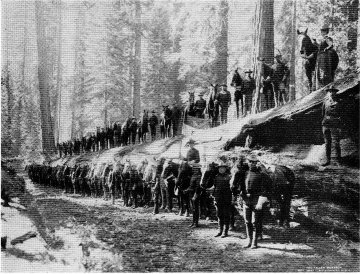
Fallen Monarch [and Troop F, 6th Cavalry]

Fallen Monarch [and Troop F, 6th Cavalry] |
by Jon Kinney, 1946-1986
NPS Ranger
This guide is available in several languages and is for sale at the Mariposa Grove. In summer, a tram is available to take you from the parking lot through the groves or you can walk the entire way.
If you’re visiting Mariposa Grove off-season,
print this webpage out ahead of time,
as this guide is sometimes not available when it’s not the peak Summer season.
I find it more peaceful and relaxing to visit the grove in the off-season.
—Dan Anderson, www.yosemite.ca.us
Converted to HTML by Dan Anderson, August 2004. These files may be used for any non-commercial purpose, provided this notice is left intact. Use of this map is subject to the disclaimer below.
Welcome to the Mariposa Grove of Giant Sequoias. If you’re impressed with these trees in the parking area, you’ll be awed by the larger trees farther ahead
These trees, Sequoiadendron giganteum, aren’t the oldest living things. Some individual living specimens of the ancient bristlecone pine, Pinus aristata, are more than 4,600 years old! The oldest Giant Sequoias may exceed 3,000 years.
And Giant Sequoias aren’t the tallest living things, either. The related coastal redwoods, Sequoia sempervirens, grow higher, up to 368 feet (112 meters). These “Sierra redwoods” top out around 310 feet (94 meters), the tallest in the Mariposa Grove is about 290 feet (88 meters).
Giant Sequoias don’t even have the greatest basal diameters. The Montezuma cypress, Taxodium mucronutum, of Mexico may exceed 50 feet (15 meters). The largest known Giant Sequoia is just over 40 feet (12 meters) in basal diameter.
So why did these trees capture the attention of the world when discovered by western Europeans in the early 1850’s? Simply stated, in total volume the Giant Sequoias are the largest living things known to humans.
On your right as you start into the grove on the main trail is the Fallen Monarch. Perhaps you’ve seen this tree before—in the famous 1899 photograph of U. S Cavalry officers on their horses up on top! Tannic acid in the wood suppresses the initial growth of fungi and bacteria, essentially arresting decay. Only when rain and melting snow have leached the tannin from the wood can decay begin. Biologists suspect that this tree had been down several hundred years before the Cavalry photograph was taken! For your safety and to help preserve what remains of the Fallen Monarch, please do not climb on it.
Notice the roots of this tree. Sequoias don’t have deep tap roots; instead, the roots spread out near the surface to capture water. While the roots are usually no deeper than six feet (2 meters), they fan out more than 150 feet (45 meters), providing a stable base to balance the massive trunk. Staying on the road and trails minimizes soil compaction that damages these surface roots.
Numerous young Sequoias line the road above the Fallen Monarch, distinguished by their foliage of round, overlapping scales; distinctive conical profiles and soft, spongy bark. Strangely, there are few young Sequoias back in the forest. Can you guess why?
To germinate, Sequoia seeds have three requirements:
But why are young Sequoias so sparse away from the road? Shortly after these trees were discovered, in a well-intended effort to protect them, people began suppressing natural fires. More shade-tolerant trees, such as white firs, incense-cedars and sugar pines, quickly spread over the forest floor, reducing sunlight, competing for moisture and blanketing the mineral soil with their needles and debris. It became impossible for Sequoia seedlings to get started.
Only lightning-caused fires, usually occurring in late summer, could reduce the competition form other evergreens and burn away the leaf litter, leaving a thin layer of nutrient-rich ash over the mineral soil. The heat from a fire dries some of the ever-present green Sequoia cones high in the mature trees, causing a shower of fresh seeds to fall after the fire onto a perfectly prepared seedbed. Beginning in November, snowstorms slowly bury the Mariposa Grove in an ever-deepening white blanket. As the snowpack melts the following spring, sunlight, moisture, fresh seeds, ash and mineral soil combine to create a Sequoia nursery.
This dependency on natural fires for Sequoia reproduction was not understood until the early 1960’s. By then, 100 years of unburned forest litter and young evergreens had accumulated, producing a massive fuel load. Had lightning ignited a fire under these unnatural conditions, an intense crown fire could have occurred, possibly killing even the largest trees. To redeuce this abnormal fuel supply and promote Giant Sequoia reproduction, the National Park Service began a series of “prescribed burns,” deliberately set and closely monitored by rangers during spring and fall. When the forest returns to a more natural state, these management fires will probably be discontinued. Then nature can resume its cycle of lightning-caused ground fires every seven to 20 years.
At the Bachelor and Three Graces up ahead you can often find the egg-shaped Sequoia cones. The crown of a mature Giant Sequoia may bear thousands of green cones at any one time. Each cone contains about 200 tiny flat seeds, roughly 1/4-inch (1 cm.) in length and resembling a rolled oak flake. These female cones grow on the upper branches. Given this vertical separation, how do the trees reproduce?
Like most conifers, Giant Sequoias depend on the wind. Late winter storms bring strong winds that carry the pollen from the lower branches of one tree to the upper branches of others, continuing the genetic mixing necessary for healthy reproduction. This vertical separation reduces the likelihood that the tree could pollinate itself. Please remember to leave all cones where you find them for other visitors to enjoy.
Before you round the curve and see the Grizzly Giant, stop for a minute and drift back in time. The year was 1852, and a Mr. Dowd was employed as a professional hunter, suppling meat to a mining camp some 75 miles north of Yosemite. One day while hunting, he stumbled upon a grove of giant cinnamon-colored trees that we know today as Calaveras Big Trees Stet Park. Mr. Dowd rushed back to camp, exclaiming that he had just found giant orange trees easily four times larger than any trees he had seen before! Mr. Dowd’s announcement was undoubtedly greeted by a hail of unkind comments about his mental stability. He left the camp but was not deterred. After an appropriate absence, he returned, announcing that he had just show an enormous grizzly bear and needed five strong men to help carry the meat back to camp. When the five men confirmed Dowd’s incredible story, the word was out.
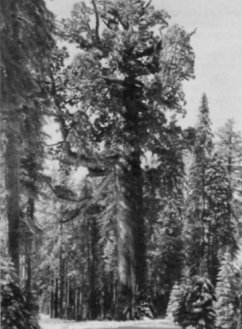
Grizzly Giant |
The Grizzly Giant is one of the largest trees in the Mariposa Grove and, at an estimated age of 2,700 years, one of the oldest living Sequoias. As you wanter around its base, look up. That huge limb on the south side is almost seven feet (2 meters) in diameter, and that mere branch is larger than the trunk of any non-Sequoia in the grove!
Some 50 yards beyond the Grizzly Giant is the California Tunnel Tree, cut in 1895 for stagecoaches. Most visitors don’t know that two trees in this grove were tunneled, one of which is still standing. Walk down and stroll through a tree!
Only an occasional large Sequoia occurs along this dry slope between the lower and upper groves. About 1/2 mile (0.8 km.) up form the Grizzly Giant, in a level area with more ground moisture, is the Faithful Couple. Here two large trees have fused together at their base but remain clearly separated above. On the opposite side of the road stand two smaller trees which may form the next “faithful couple” 500 years from now.
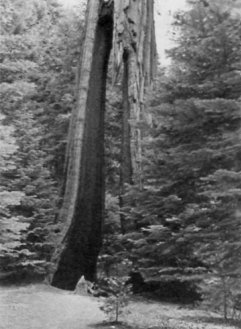
Clothespin Tree |
A 1/4 mile further is the Clothespin Tree. Numerous fires have excavated a natural tunnel wide enough for a car. Size is deceptive here, so walk up and stand in the opening.
The Spanish named this region Mariposa for the many butterflies they observed in the foothills. One of the most perfectly shaped Sequoias, the Mariposa Tree, carries the name of this county. Notice the almost completely healed fire scar near the base of this magnificent tree
Another 1/4 mile (0.4 km.) will take you to the Mariposa Grove Museum. This fine cabin, built in 1930 and restored in 1983, occupies the site where Galen Clark built a small cabin in 1861. Inside are exhibits on the ecology and history of Giant Sequoias.
|
Please help preserve this magnificent forest
and leave all cones where you find them. |
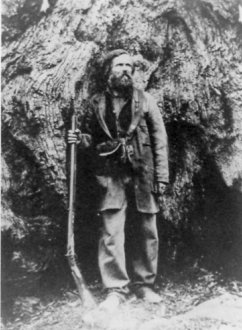
Galen Clark |
Another 1/2 mile (0.8 km.) straight ahead from the museum junction is the top of the upper grove. Directly in front stands the Galen Clark Tree, named for the man who did so much to protect these trees. In 1861 Clark first entered this grove, probably up the draw ahead of you. He was so impressed that he spent the rest of his life guiding visitors among these wonders and urging their protection.
In 1864 Abraham Lincoln paused during the Civil War to set aside the Mariposa Grove and Yosemite Valley as a protected state reserve “for the pleasuring of the people.” Mr. Clark lived to see Yosemite National Park established in 1890 and this grove incorporated into the park in 1906. Along with John Muir, Galen Clark was instrumental in Yosemite’s preservation, and it is fitting that this beautiful tree bears his name as a living memorial.
To your left an easy side road leads 1/4 mile (0.4 km.) to Wawona Point, offering an ideal lunch stop with a stunning view.
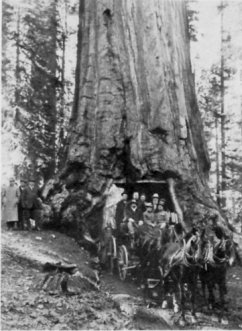
Wawona Tunnel Tree |
Turning right from the Galen Clark Tree soon brings you to perhaps the most famous tree in the world, the fallen Wawona Tunnel Tree. Who knows how many millions of visitors drove through this tree between 1881 when the tunnel was cut and 1969 when it finally collapsed under a record snowpack. Weakened by the massive hole in its base, it may have died 1,000 years prematurely. But the stories and pictures of this gentle giant traveled around the world and undoubtedly contributed to the preservation of its breathren.
Returning along the upper grove loop road, you’ll find a real sleeper, the Telescope Tree. Close your eyes and walk inside. With your eyes still closed, lean your head back and slowly open your eyes. Incredible! And this amazing tree is still alive and producing viable seeds. It’s these trees’ resistance to fire, disease, insects and decay that allows them to live through the centuries. Only by toppling do they finally succumb. The Telescope Tree is a notable example of their endurance.
A wise man once said, “A culture is measured by what it preserves.” Although Yellowstone became our first designated national park in 1872, the idea budded here in this grove at least eight years earlier. Perhaps America’s national park idea is our noteworthy contribution to the spiritual wealth of mankind.
Tuck this pamphlet away and walk slowly back down, letting this special place touch you.
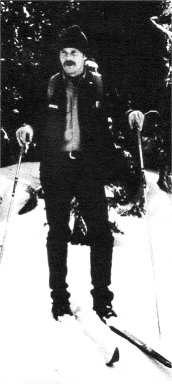
Jon Kinney |
We provide these maps as a free service. While we’re satisfied that the maps are accurate in the majority of cases, we are aware that some are not and make no guarantee as to their accuracy. These maps are provided "as is" in the hope that it will be useful, but WITHOUT ANY WARRANTY, to the extent permitted by law; without even the implied warranty of MERCHANTABILITY or FITNESS FOR A PARTICULAR PURPOSE. Please use these maps as a guide and not as definitive information.
Copyright © 2004 Dan Anderson. All rights reserved.
Last updated
27 September 2021.
If you have questions or comments, please send a message to Dan Anderson.
http://www.yosemite.ca.us/mariposa_grove_of_giant_sequoias/